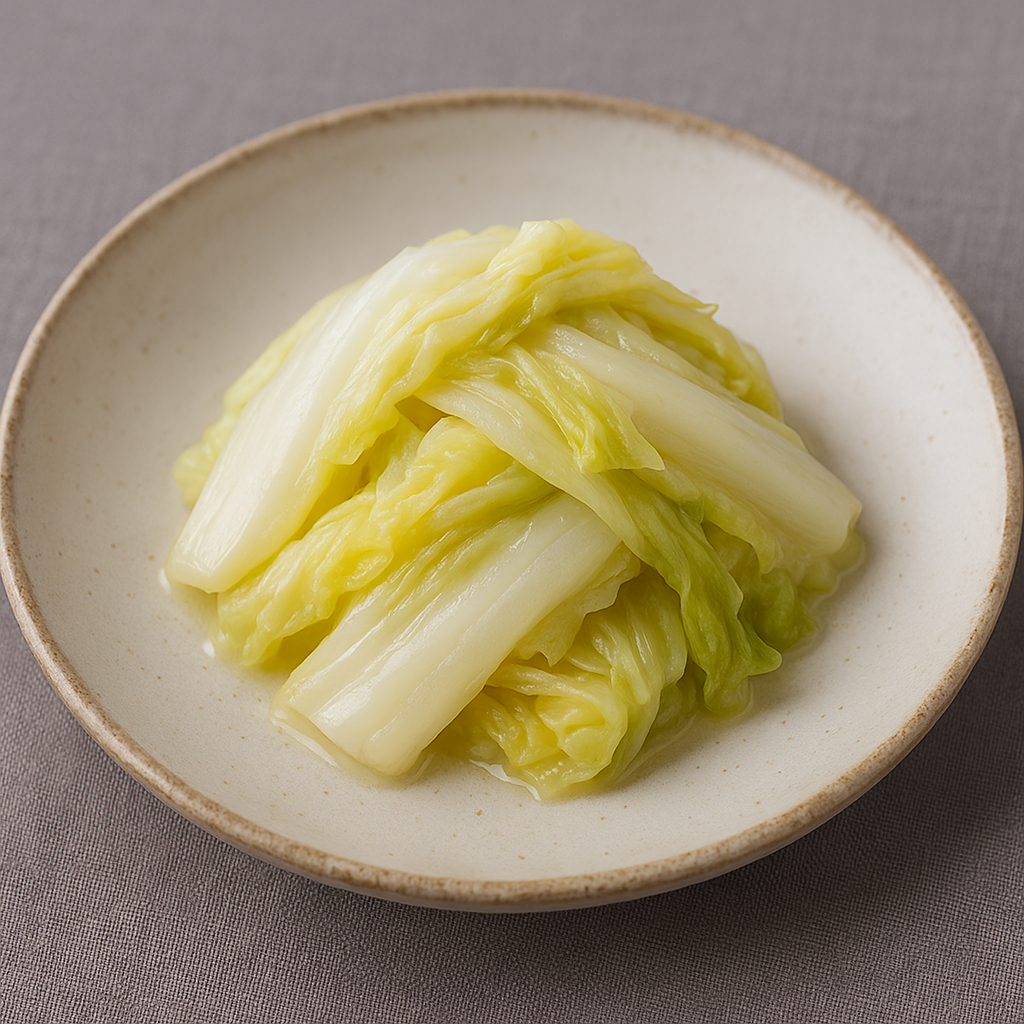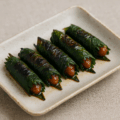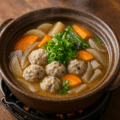仙台白菜の漬物(宮城)の特徴
やわらかな甘みと歯切れのよさ
仙台周辺で親しまれる「仙台白菜」は葉がやわらかく、ほどよい甘みとみずみずしさが持ち味です。浅漬けにすると歯切れよく、白菜本来の香りと甘みが引き立ちます。
昆布と唐辛子で旨みと香りを添えます
基本は塩だけのシンプルな配合ですが、細切り昆布で旨みを、赤唐辛子やゆず皮で香りを添えると、後味のキレと広がりが生まれます。
仙台白菜の漬物(宮城) レシピ
材料(作りやすい分量)
- 仙台白菜(または白菜) … 正味800g
- 塩 … 16g(白菜重量の2%目安)
- 昆布(細切り、または5cm角) … 5g(または1枚)
- 赤唐辛子(輪切り) … 少々(お好みで)
- 砂糖 … 小さじ1(お好みで・甘口に)
- ゆず皮(せん切り) … 少々(仕上げ用)
作り方
- 白菜は外葉を外して洗い、水気をよく切る。芯はそぎ落とし、食べやすい3〜4cm幅に切る(太い芯は縦に切れ目を入れて厚みをそろえる)。
- 大きめのボウルに白菜を入れ、塩を全体に振って軽くもみ、昆布・赤唐辛子・砂糖を加えてさらにざっと混ぜる。
- 保存袋または容器に詰め、落としラップをしてから重し(白菜の1/3〜1/2程度)をのせる。常温で1〜2時間置いて水が上がったら、冷蔵庫で4時間〜一晩漬ける。
- 食べる直前に軽く汁気を絞り、ゆず皮を加えてさっと和える。塩気が強い場合は手早く水で洗ってから絞る。
- 器に盛り、好みで昆布や唐辛子も添える。
シェフのワンポイントアドバイス
- 塩は2%が基準。短時間なら1.5%、長めに漬けるなら2.5〜3%に調整します。
- もみ込みはやさしく。強く揉みすぎると水っぽくなり、歯切れが損なわれます。
- 芯は薄め、葉は大きめに切ると、食感のコントラストがきれいに出ます。
- 漬け上がりは冷蔵で2〜3日がおいしい目安。保存は漬け液ごとが基本で、水分から飛び出ているとカビが生えやすくなります。
栄養価(1人分の目安/約150g)
- エネルギー … 約25kcal
- たんぱく質 … 約1.5g
- 脂質 … 約0.3g
- 炭水化物 … 約6g
- 食塩相当量 … 約2.0g
- 特徴成分 … ビタミンC・カリウム・食物繊維を含みます
歴史
冬の常備菜として根づきました
寒さに強い白菜は宮城の冬野菜の代表格で、塩だけで手早く漬ける浅漬けや、樽で漬ける本漬けとして家庭で親しまれてきました。
地場の白菜の個性を生かす漬け方
葉がやわらかい仙台白菜は浅漬けに向き、昆布やゆず、唐辛子を加えることで土地の香りを映した一品に仕上がります。
食卓の名脇役として受け継がれています
焼き魚や揚げ物の箸休め、茶漬けの友として、さっぱりと口を整える定番の副菜として受け継がれています。
English Version
Features of Pickled Sendai Hakusai (Miyagi)
Tender sweetness with a clean, crisp bite
Sendai’s local napa cabbage (“Sendai hakusai”) is prized for soft leaves, gentle sweetness, and juiciness. As a quick pickle, it stays snappy and highlights the cabbage’s natural aroma and sweetness.
Kombu and chili add umami and fragrance
The base is simply salt, but a touch of shredded kombu lends umami, while red chili and yuzu zest bring lift and a refreshing finish.
Recipe – Pickled Sendai Hakusai (Miyagi)
Ingredients (Easy batch)
- Sendai hakusai (or napa cabbage), trimmed … 800 g net
- Salt … 16 g (about 2% of cabbage weight)
- Kombu (shredded or a 5 cm square) … 5 g (or 1 piece)
- Red chili, sliced … a little (optional)
- Sugar … 1 tsp (optional, for a mild sweetness)
- Yuzu zest, julienned … a little (to finish)
Directions
- Remove outer leaves and wash well; drain thoroughly. Trim thick core; cut into 3–4 cm pieces (score thick ribs lengthwise so thickness is even).
- In a large bowl, toss cabbage with salt gently. Add kombu, chili, and sugar; mix again lightly.
- Pack into a bag or container. Press with plastic wrap directly on the surface and add a weight (about 1/3–1/2 the cabbage weight). Leave at cool room temperature 1–2 hours until brine rises, then refrigerate 4 hours to overnight.
- Before serving, squeeze lightly. Add yuzu zest and toss. If too salty, give a quick rinse and squeeze well.
- Plate the cabbage; add kombu or chili to taste.
Chef’s Tips
- 2% salt is the baseline. Use ~1.5% for very short pickling; 2.5–3% if pickling longer.
- Massage gently. Overworking forces out too much water and dulls the texture.
- Cut ribs thinner and leaves larger to create a pleasing contrast in bite.
- Keep all cabbage submerged in brine under a weight; exposure leads to spoilage and mold.
- Best within 2–3 days, stored in its brine and kept chilled.
Nutrition (per serving, ~150 g)
- Energy … ~25 kcal
- Protein … ~1.5 g
- Fat … ~0.3 g
- Carbohydrates … ~6 g
- Salt equivalent … ~2.0 g
History
A winter staple side in Miyagi
Hardy napa cabbage is a defining winter vegetable in Miyagi. Quick salted pickles and barrel-pickled versions alike have long been everyday fare.
Bringing out the local cabbage’s character
With its soft leaves, Sendai hakusai shines in light pickles; kombu, yuzu, and chili add a regional touch and aromatic depth.
A classic supporting role at the table
Served with grilled fish, fried foods, or even with tea over rice, it cleanses the palate and remains a beloved, simple side dish.



何でも質問してください!